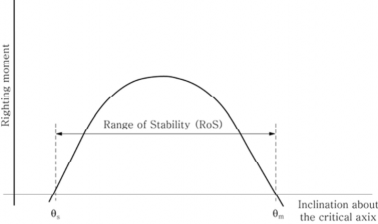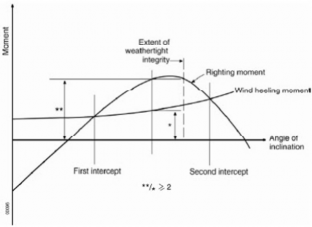

< Previous | Contents | Next >
Section 4 Subdivision and Damage Stability
401. Surface and self-elevating units
1. In general, the flooding of any one compartment in any operating or transit condition consistent with the damage assumptions set out in Sec 5; and
2. For a self-elevating unit, the flooding of any single compartment while meeting the following rion (see Fig 4.2):
crite-
≥
where,
≥
: range of stability, in degrees
where,
: maximum angle of positive stability, in degrees
: static angle of inclination after damage, in degrees
The range of stability is determined without reference to the angle of downflooding.
![]()

Fig 4.2 Residual Stability for Self-elevating Units
402. Column-stabilized units
1. The unit should have sufficient freeboard and be subdivided by means of watertight decks and bulkheads to provide sufficient buoyancy and stability to withstand a wind heeling moment induced by a wind velocity of 25.8 m/s (50 knots) superimposed from any direction in any operating or transit condition, taking the following considerations into account:
(1) the angle of inclination after the damage set out in 503. 1 (2) should not be greater than 17°;
(2) any opening below the final waterline should be made watertight, and openings within 4 m above the final waterline should be made weathertight;
(3) the righting moment curve, after the damage set out above, should have, from the first intercept with the wind heeling moment to the lesser of the extent of weathertight integrity under para- graph (2) and the second intercept, a range of at least 7°. Within this range, the righting mo-
ment curve should reach a value of at least twice the wind heeling moment curve, both being measured at the same angle.(See Fig 4.3) (Refer to An example of alternative stability criteria
for a
range of positive stability after damage or flooding for column-stabilized semisubmersible
units, adopted by the Organization by resolution A.651(16)).

Fig 4.3 Righting moment and heeling moment curves
![]()
2. The unit should provide sufficient buoyancy the assumption of no wind to withstand the
and stability in any operating or transit condition with flooding of any watertight compartment wholly or par-
tially below the waterline in question, which is a pump-room, a room containing machinery with a
salt water cooling system or a compartment adjacent to the sea, taking the following considerations into account:
(1) the angle of inclination after flooding should not be greater than 25°;
(2) The final waterline is to be located below the lower edge of any opening that does not meet the requirements in 602. 2 and 3. However, no openings are provided in column.;
(3) Sufficient margin of stability is provided which requires a range of positive stability of at least
7° beyond the first intercept of the righting moment curve and the horizontal coordinate axis of the static stability curve to the second intercept of them or the downflooding angle, whichever
is less.
403. All types of units
1. Compliance with the provisions of 401. 1 to 402. 2 should be determined by calculations which take into consideration the proportions and design characteristics of the unit and the arrangements and configuration of the damaged compartments. In making these calculations, it should be assumed that the unit is in the worst anticipated service condition as regards stability and is floating free of mooring restraints.
2. The ability to reduce angles of inclination by pumping out or ballasting compartments or applica- tion of mooring forces, etc., should not be considered as justifying any relaxation of these provisions.
3. Alternative subdivision and damage stability criteria may be considered for approval by the Society provided an equivalent level of safety is maintained. In determining the acceptability of such cri- teria, the Society should consider at least the following and take into account:
(1) extent of damage as set out in Sec 5;
(2) on column-stabilized units, the flooding of any one compartment as set out in 402. 2;
(3) the provision of an adequate margin against capsizing.